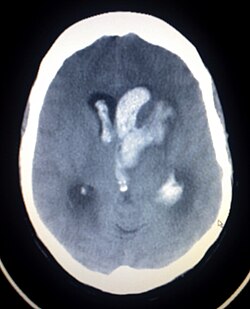Intracranial hemorrhage

Editor-In-Chief: Prab R Tumpati, MD
Obesity, Sleep & Internal medicine
Founder, WikiMD Wellnesspedia &
W8MD medical weight loss NYC and sleep center NYC
| Intracranial hemorrhage | |
|---|---|

| |
| Synonyms | Brain hemorrhage, Cerebral hemorrhage |
| Pronounce | N/A |
| Specialty | N/A |
| Symptoms | Headache, vomiting, seizures, decreased level of consciousness |
| Complications | Stroke, brain herniation, coma |
| Onset | Sudden |
| Duration | Variable |
| Types | N/A |
| Causes | Trauma, hypertension, aneurysm, arteriovenous malformation |
| Risks | Hypertension, smoking, alcohol use disorder, anticoagulant use |
| Diagnosis | CT scan, MRI |
| Differential diagnosis | Ischemic stroke, brain tumor, meningitis |
| Prevention | N/A |
| Treatment | Surgery, medication to control blood pressure, supportive care |
| Medication | N/A |
| Prognosis | Variable, depends on size and location of hemorrhage |
| Frequency | Common |
| Deaths | N/A |
Intracranial hemorrhage (ICH) refers to any bleeding that occurs inside the skull. ICH is a serious medical condition that requires immediate medical attention.
Types of Intracranial Hemorrhage[edit]
There are several types of intracranial hemorrhage, including:
- Epidural hematoma - This occurs when blood accumulates between the dura mater and the skull. It is often caused by a skull fracture.
- Subdural hematoma - This is when blood collects on the surface of the brain, usually due to a severe head injury.
- Subarachnoid hemorrhage - This is bleeding into the subarachnoid space, which is the area between the brain and the tissues that cover it. This is often caused by a ruptured aneurysm.
- Intracerebral hemorrhage - This is when bleeding occurs within the brain tissue itself. This can be caused by a variety of conditions, including hypertension, aneurysm, arteriovenous malformations, and tumors.
Symptoms[edit]
The symptoms of an intracranial hemorrhage can vary depending on the location and severity of the bleeding, but may include:
- Headache
- Nausea and vomiting
- Seizures
- Loss of consciousness
- Weakness or numbness on one side of the body
- Difficulty speaking or understanding speech
- Vision problems
Diagnosis[edit]
Diagnosis of an intracranial hemorrhage typically involves a neurological examination, imaging tests such as a CT scan or MRI, and sometimes a lumbar puncture.
Treatment[edit]
Treatment for an intracranial hemorrhage depends on the cause, location, and severity of the bleeding. It may include:
- Surgery to remove the blood or repair the source of the bleeding
- Medications to control symptoms and prevent further bleeding
- Rehabilitation to help regain lost skills and abilities
See Also[edit]
Ad. Transform your life with W8MD's Budget GLP-1 injections from $75


W8MD offers a medical weight loss program to lose weight in Philadelphia. Our physician-supervised medical weight loss provides:
- Weight loss injections in NYC (generic and brand names):
- Zepbound / Mounjaro, Wegovy / Ozempic, Saxenda
- Most insurances accepted or discounted self-pay rates. We will obtain insurance prior authorizations if needed.
- Generic GLP1 weight loss injections from $75 for the starting dose.
- Also offer prescription weight loss medications including Phentermine, Qsymia, Diethylpropion, Contrave etc.
NYC weight loss doctor appointmentsNYC weight loss doctor appointments
Start your NYC weight loss journey today at our NYC medical weight loss and Philadelphia medical weight loss clinics.
- Call 718-946-5500 to lose weight in NYC or for medical weight loss in Philadelphia 215-676-2334.
- Tags:NYC medical weight loss, Philadelphia lose weight Zepbound NYC, Budget GLP1 weight loss injections, Wegovy Philadelphia, Wegovy NYC, Philadelphia medical weight loss, Brookly weight loss and Wegovy NYC
|
WikiMD's Wellness Encyclopedia |
| Let Food Be Thy Medicine Medicine Thy Food - Hippocrates |
Medical Disclaimer: WikiMD is not a substitute for professional medical advice. The information on WikiMD is provided as an information resource only, may be incorrect, outdated or misleading, and is not to be used or relied on for any diagnostic or treatment purposes. Please consult your health care provider before making any healthcare decisions or for guidance about a specific medical condition. WikiMD expressly disclaims responsibility, and shall have no liability, for any damages, loss, injury, or liability whatsoever suffered as a result of your reliance on the information contained in this site. By visiting this site you agree to the foregoing terms and conditions, which may from time to time be changed or supplemented by WikiMD. If you do not agree to the foregoing terms and conditions, you should not enter or use this site. See full disclaimer.
Credits:Most images are courtesy of Wikimedia commons, and templates, categories Wikipedia, licensed under CC BY SA or similar.
Translate this page: - East Asian
中文,
日本,
한국어,
South Asian
हिन्दी,
தமிழ்,
తెలుగు,
Urdu,
ಕನ್ನಡ,
Southeast Asian
Indonesian,
Vietnamese,
Thai,
မြန်မာဘာသာ,
বাংলা
European
español,
Deutsch,
français,
Greek,
português do Brasil,
polski,
română,
русский,
Nederlands,
norsk,
svenska,
suomi,
Italian
Middle Eastern & African
عربى,
Turkish,
Persian,
Hebrew,
Afrikaans,
isiZulu,
Kiswahili,
Other
Bulgarian,
Hungarian,
Czech,
Swedish,
മലയാളം,
मराठी,
ਪੰਜਾਬੀ,
ગુજરાતી,
Portuguese,
Ukrainian


